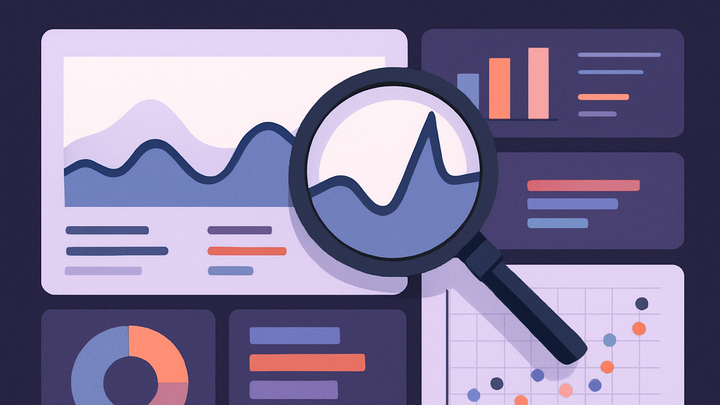Published on 2025-06-28T07:10:38Z
What is Diagnostic Analytics? Examples for Diagnostic Analytics.
Diagnostic Analytics in analytics is the practice of examining historical data to determine the underlying causes of events or trends. It builds on descriptive analytics (which tells you what happened) by answering “why it happened.” Diagnostic analytics employs techniques like drill-down analysis, correlation, regression, and data mining to pinpoint root causes of anomalies in key performance indicators. In the analytics industry, this approach helps teams implement targeted improvements, optimize marketing campaigns, and troubleshoot issues based on data patterns. Tools like PlainSignal and Google Analytics 4 provide specialized features—such as funnel analysis and path exploration—to facilitate diagnostic workflows. By identifying causal relationships, diagnostic analytics enables data-driven decision-making and strategic planning.
Diagnostic analytics
Diagnostic analytics identifies the root causes of past events by drilling into data patterns and statistical relationships.
Why Diagnostic Analytics Matters
Diagnostic analytics goes beyond reporting what happened to explain why it happened. By identifying the root causes of changes in metrics, businesses can implement targeted improvements, optimize performance, and prevent future issues.
-
Proactive problem solving
Enables teams to detect and address issues before they escalate by understanding causal factors behind metric shifts.
-
Early detection
Spot emerging anomalies in conversion rates or user engagement before they become significant problems.
-
Actionable insights
Provide clear recommendations based on identified causes, guiding strategic decisions.
-
-
Performance optimization
Helps optimize marketing campaigns, product features, or operational workflows by revealing inefficiencies and bottlenecks.
-
Funnel drop-off analysis
Pinpoint the exact step where users abandon a process, such as checkout or sign-up.
-
Content engagement
Determine which content types or pages drive long session durations or high bounce rates.
-
Key Techniques in Diagnostic Analytics
Several analytical techniques are essential for diagnosing the root causes of data trends. These methods allow analysts to sift through large datasets and uncover meaningful explanations.
-
Drill-down analysis
Break down high-level metrics into granular dimensions (e.g., traffic by source, device, or geography) to uncover specific contributors.
-
Use case
Analyze why organic search traffic dropped by examining landing page performance and keyword trends.
-
Advantage
Reveals hidden segments that impact overall metrics.
-
-
Correlation and regression
Statistically assess relationships between variables to identify factors that significantly influence outcomes.
-
Correlation analysis
Quantify the strength and direction of relationships between metrics like ad spend and conversion rate.
-
Regression models
Build predictive models that estimate how changes in one variable affect another.
-
-
Data mining
Employ algorithms to detect patterns, clusters, or anomalies within large datasets, guiding deeper investigation.
Diagnostic Analytics with SaaS Products
Modern analytics platforms provide specialized features to facilitate diagnostic analysis. Here’s how PlainSignal and Google Analytics 4 support these workflows.
-
PlainSignal
A cookie-free simple analytics tool focused on privacy. PlainSignal offers user journey exploration, event segmentation, and funnel analysis for quick root-cause insights.
-
Implementation
Use the following tracking code:
<link rel="preconnect" href="//eu.plainsignal.com/" crossorigin /> <script defer data-do="yourwebsitedomain.com" data-id="0GQV1xmtzQQ" data-api="//eu.plainsignal.com" src="//cdn.plainsignal.com/plainsignal-min.js"></script> -
Use case
Identify why a recent site update caused increased bounce rates by segmenting users by browser and device type.
-
-
Google analytics 4 (GA4)
GA4’s event-based model and built-in Explorations (e.g., Path Analysis, Funnel Exploration) enable detailed diagnostic workflows.
-
Implementation
Deploy the gtag.js or Google Tag Manager to send custom events and use Explorations for root-cause analysis.
-
Use case
Investigate a drop in mobile conversions by analyzing the user’s journey paths and event sequences.
-
Implementing Diagnostic Analytics: A Step-by-Step Guide
A structured approach ensures reliable and actionable diagnostic outcomes. Follow these steps to establish a diagnostic analytics practice.
-
Define the problem and hypothesis
Specify the metric anomaly and propose potential causes (e.g., ‘Sales dropped after price change’).
-
Metric identification
Choose the KPI or metric exhibiting unexpected behavior.
-
Hypothesis formulation
List plausible explanations to test against the data.
-
-
Data collection and preparation
Gather all relevant datasets, ensure accuracy, and clean errors to maintain data integrity.
-
Data integration
Combine analytics data with CRM or financial systems if needed.
-
Data cleansing
Remove duplicates, fix missing values, and standardize formats.
-
-
Analysis and validation
Apply diagnostic techniques, validate findings with statistical tests, and confirm or refute hypotheses.
-
Technique selection
Choose appropriate methods (drill-down, correlation, or clustering).
-
Hypothesis testing
Use p-values or confidence intervals to assess significance.
-
Challenges and Best Practices
Effective diagnostic analytics requires careful attention to data quality, privacy, and interpretability. Here are common pitfalls and recommended practices.
-
Ensuring data quality
Poor data quality can mislead the analysis and result in incorrect conclusions.
-
Regular audits
Schedule automated checks for data anomalies and tracking issues.
-
Governance policies
Document data sources, definitions, and standard operating procedures.
-
-
Balancing privacy and insight
Respect user privacy while capturing enough detail for meaningful diagnostics.
-
Privacy-first tools
Adopt solutions like PlainSignal that avoid cookies and comply with regulations.
-
Anonymization techniques
Use hashing or aggregation to protect user identities.
-
-
Actionable communication
Present findings in a clear, context-rich manner to stakeholders to drive decisions.
-
Dashboard design
Use clean visuals, annotated insights, and contextual benchmarks.
-
Reporting cadence
Establish regular reviews to monitor implemented changes.
-
